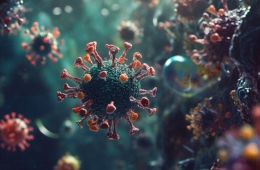
Adeno-associated virus (AAV) is a non-enveloped virus that can transport DNA to target cells through genetic engineering, and it has garnered significant attention in the field of gene therapy. Our company aims to better understand AAV vector gene delivery and activation of gene expression to help customers develop AAV vectors for gene therapy of rare diseases. Our improved vector manufacturing and efficiency for AAV gene therapy bring superior quality to the rapidly growing gene therapy market.
Adeno-associated virus (AAV) is a protein shell that surrounds and protects a small, single-stranded DNA genome of approximately 4.8kb. Its single-stranded genome contains three genes: Rep (replication), Cap (capsid), and AAP (assembly). The discovery of DNA as the biological molecule responsible for genetic inheritance and diseases has opened up prospects for improving human conditions by altering mutated genes. Many viral vectors can be chosen to deliver the target nucleic acid (DNA or RNA) into host cells for replication. Each of them has some unique properties, and adenovirus-associated vectors are currently one of the most active gene therapy vectors under research.
 Fig.1 Protocol of rAAV production. (Fernandez-Sendin, M., et al., 2020)
Fig.1 Protocol of rAAV production. (Fernandez-Sendin, M., et al., 2020)
In recombinant AAV (rAAV) vectors used for gene therapy, natural coding, and non-coding viral genes are replaced by a transgenic cassette with a total coding capacity of approximately 4.7 kb. This cassette is integrated between the inverted terminal repeats (ITR) and typically includes tissue-specific or ubiquitously present promoters, transgene sequences, and polyadenylation (polyA) signals.
The mainstream gene delivery method is virus-mediated delivery, and currently, among viral vectors, AAV (Adeno-Associated Virus) is the most widely used delivery vector in vivo gene therapy applications due to its excellent tissue specificity, low immunogenicity, and high safety. Gene therapy using AAV as the vector primarily targets the eye, brain, muscles, and liver. Research has shown that AAV gene therapy can treat some rare diseases.
Table 1 Application of AAV serotypes in rare diseases. (Li, Chengwen, and R. Jude Samulski., 2020)
| AAV serotype | Origin of isolation | Primary receptor | Co-receptor | Tissue tropism | Condition | Approved drug |
| AAV1 | Monkey | Sialic acid | AAVR | Muscle, CNS, heart | AAT deficiency (NCT01054339, NCT00430768) |
None |
| AAV2 | Human | Heparin | Integrin, FGFR, HGFR, LamR, AAVR | Liver, CNS, muscle | Haemophilia (NCT00515710) | Luxturna for Leber congenital amaurosis |
At our company, we are at the forefront of adeno-associated viral (AAV) vector development, leveraging our extensive expertise and state-of-the-art technologies to drive innovation in the field of gene therapy. As a leading provider of AAV-based gene delivery solutions, we are committed to empowering our partners and clients with transformative tools that can unlock the full potential of gene-based interventions to support the development of rare disease therapies.
We have three major AAV vector platforms that simplify the development process of AAV vectors and enhance their functions. Our proprietary AAV platform is a testament to our commitment to innovation.

AAV-Stable
Utilizing inducible cell lines for stable and scalable production of AAV vectors.

AAV-Find
Identify novel AAV variants with enhanced tissue-specific targeting capabilities and overcome barriers to translation from animals to humans.

AAV-Expand
Overcoming packaging limitations by employing dual or multiple AAV systems for larger therapeutic genes.
Based on our AAV expertise, our advanced delivery technology has been proven.

Intravitreal Injection Vectors: We have developed a number of AAV vectors that can be used for intravitreal injection and have been repeatedly validated in both small and large animals.
Leveraging our innovative platform, we are committed to providing our clients with a one-stop AAV development solution to support the development of rare disease drugs and therapies.


Our cutting-edge Stable system: an innovative inducible cell line that revolutionizes AAV manufacturing. This streamlined method ensures high-yield, cost-effective, and scalable AAV vector production for expanded commercial utility.

With extensive experience in rare disease therapy research and development, our company provides customers with a convenient solution. Our adeno-associated viral vector development service is a simplified workflow by a group of specially trained and professional scientists. If you are interested in our services, please feel free to contact us for more details and quotation information of related services.
References
